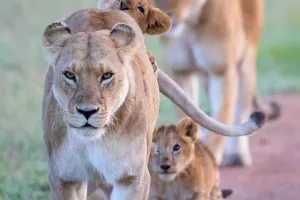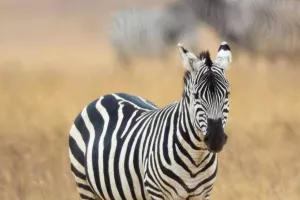It’s not hard to be mesmerized and amazed by elephants! But, did you know there’s even more to these majestic critters? If you’re curious to know about what makes these super-sized mammals tick, you’ve come to the right place! These fascinating elephant facts will fill you in on their unique quirks!
1. THEY’RE THE WORLD’S LARGEST LAND ANIMAL
The African elephant is the world's largest land animal – with adult males, or bull elephants, standing up to 3m high and weighing up to 6,000kg on average. Males only reach their full size at 35-40 years - that’s well over half their lifespan as wild elephants can live for up to 60-70 years. And it’s not just the adults – even calves are huge! At birth, a baby elephant can weigh 120kg - that’s almost 19 stone.
2. YOU CAN TELL THE TWO SPECIES APART BY THEIR EARS
There are two species of elephant: African and Asian. The ears of African elephants are much larger than their cousins and are described as being shaped like the African continent, whereas the ears of Asian elephants are shaped like the Indian subcontinent. There’s also a trunk difference - African elephants have two ‘fingers’ at the tip of their trunks, whereas Asian elephants have one.
3. THEIR TRUNKS HAVE MAD SKILLS
Elephants have around 150,000 muscle units in their trunk. Their trunks are perhaps the most sensitive organ found in any mammal - Asian elephants have been seen to pick up a peanut, shell it, blow the shell out and eat the nut. Elephants use their trunks to suck up water to drink – it can contain up to 8 litres of water. They also use their trunks as a snorkel when swimming.
4. THEIR TUSKS ARE ACTUALLY TEETH
Elephant tusks are actually enlarged incisor teeth which first appear when elephants are around 2 years old. Tusks continue growing throughout their lives. Tusks are used to help with feeding - prising bark off trees or digging up roots - or as a defense when fighting. But these beautiful tusks often cause elephants danger. They're made from ivory; a much desired object. Read on to find out why elephants are under threat.
5. THEY’VE GOT THICK SKIN
An elephant’s skin is 2.5cm thick in most places. The folds and wrinkles in their skin can retain up to 10 times more water than flat skin does, which helps to cool them down. They keep their skin clean and protect themselves from sunburn by taking regular dust and mud baths.
6. ELEPHANTS ARE CONSTANTLY EATING
Elephants eat grasses, leaves, shrubs, fruits and roots depending on the season and their habitat. When it’s particularly dry, elephants will eat more woody parts of trees and shrubs like twigs, branches and barks. They need to eat up to 150kg of food per day – that's around 375 tins of baked beans – although half of this may leave the body undigested. Elephants eat so much that they can spend up to three-quarters of their day just eating.
7. THEY COMMUNICATE THROUGH VIBRATIONS
Elephants communicate in a variety of ways - including sounds like trumpet calls (some sounds are too low for people to hear), body language, touch and scent. They can also communicate through seismic signals - sounds that create vibrations in the ground - which they may detect through their bones.


